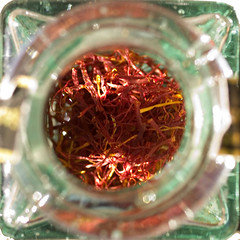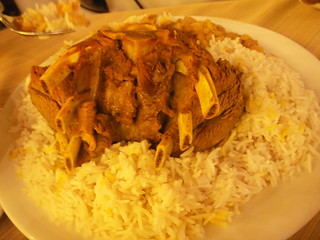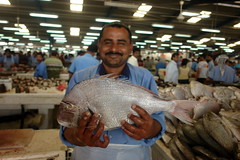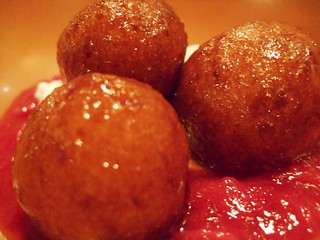Food In Abu Dhabi: Five To Try

Abu Dhabi.
The first thing that comes to mind is the desert, right? And the desert means no food and no water. The desert is synonymous with endless sand dunes, starvation and death, basically. There can’t possibly be good food in the desert, right?
Wrong!
Enter Abu Dhabi: A place in the desert not only with a stunning coastline and a thriving fishing industry, but a fascinating food culture as well. Good food in the desert? Absolutely! There’s even good dessert in the desert.
Abu Dhabi is a place where you can find virtually any kind of international cuisine should you desire it. Italian, French, Chinese, Japanese, American, Mexican, Indian, you name it. But why go all the way to Abu Dhabi (or anywhere, for that matter) and eat the same food you could get back home? Why not try the delicious things you can’t find in your country?
Half of the fun of international travel for me is discovering what food I have been missing by not living in whatever area I happen to be visiting. In my experience, the little, weathered old granny cooking over a propane tank on a street corner has a lot more knowledge and tricks up her sleeve than the fancy cook in the restaurant a few meters away. And she’s a lot more fun to talk to.
So, when in Abu Dhabi, try out the local cuisine! It is rooted in the Middle Eastern cooking traditions and has its own fantastic flavors and flair. Simple, but meticulous. Spicy, but subtle. Delicate, but flavorful.
OK, you’re thinking, they have kebabs, shawarma, hummus, and tabbouleh. Well, yes, but those are really more recent additions to the cuisine, and don’t do the Emirati diet justice. The traditional dishes rely heavily on fresh fish, meat, and rice, and are simple and healthy. The real key to the Emirati flavor is a secret combination of spices: cardamom, saffron, carmon seeds, cinnamon, ginger, black pepper, rose water, and dried lemon (OK, maybe it’s not such a secret blend).
So on your next trip, put down that burger or pizza and try these five food in Abu Dhabi:
1. Harees
Harees is a simple, traditional dish made of wheat, meat (usually chicken) and salt. It may take a long while to cook, but it is definitely worth the wait. It is a must-have at special meals like weddings, and during Ramadan. It is made by cooking ground wheat in a pot with a little bit of salt,and then adding the meat. It then simmers for a few hours until it is fully cooked and the meat has completely broken down and dissolved into the wheat.
Now if you stop right there, it sounds like you’re making pulled pork or pulled chicken, minus the wheat. That’s where the similarity ends.
Here’s the next step: Put it all in a clay pot and bury it in a hole in the ground filled with hot coals. WOW! Anything cooked in the ground is just cool. OK, not everyone cooks it in the ground, you can also put the pot in a clay oven. Not as cool, but probably less likely to get you in trouble for digging up your neighbor’s yard.
A few hours later, the mixture is taken out and stirred with a “midrib”, a very special piece of wood that I would personally just call a “wooden spoon”. At last, the harees is finished and it’s time to enjoy it. Serve it on a plate and top it with ghee and you have yourself a nice, filling, delicious meal.
Now, settle down, save some room for the next course…
2. Machboos
Also known as Majboos or Makboos, this dish is fairly simple: meat and rice. If this doesn’t sound great, then you have forgotten about the secret blend of spices! In most countries this dish is made with chicken as the meat. Here in Abu Dhabi, no animal is safe (except pigs, of course).
You can find it with beef , goat, lamb or even delicious shrimp. The meat gets cooked first in water with the secret blend. Then, fried chopped onion is added, followed closely by a vegetable medley , usually potatoes, tomatoes, and green peppers. After simmering for a while, they add the magical ingredient that makes everything better, saffron, and layer the rice and everything else together.
Another 10 minutes in the oven and it is ready to light up your palate, and you’ll understand why good cooks always say, “Simple is best.”
Wait! Save some room! The next course is…
3. Salona
Salona is great for vegetarians who love meat, like me. This dish is a favorite of many local foodies, and is basically a meat soup.
“Meat soup? Meh,” you may say.
If you said, “Meh”, then you may now slap yourself. You forgot about the secret blend, silly! And the vegetable medley that goes into it makes it a nutritional powerhouse in a bowl.
They boil the meat with onions (see a pattern forming?) and add in fresh, local vegetables like okra, bell peppers, eggplant, and courgettes. Finally, they add in tomato paste alongside the aforementioned spices and after a quick simmer it is finished. Believe me, it looks as good as it tastes.
Can you smell it? Is your mouth watering?
Just wait until you try the next course…
4. Madrooba
The crown jewel of Emirati cuisine is fresh seafood. You can find the endless varieties of fish here in a rainbow of colors, shapes and sizes at the local markets. Seafood is grilled, fried, simmered, poached, boiled, and prepared probably any other way you can imagine. This means that there are a lot of seafood dishes to choose from.
Another local favorite is again, a simple one: madrooba. Madrooba is prepared using any kind of fish that has been salt-cured, called “maleh”. Maleh is considered a delicacy all across the UAE, and so it’s no surprise why this dish is so popular.
Now, in the west, we don’t eat a lot of salt-cured fish, so you may be thinking, “Ugh, what a salt-fest.” Not true!
They rinse the fish thoroughly, and thus the dish isn’t as salty as you would think. It is cooked in a pot of water flavored with the now familiar spice blend and bit by bit, flour is added and mixed in, slowly thickening the broth into a delicate, savory sauce.
And as if that weren’t enough, it is topped with our old friend, ghee. You’re going to want to have some flat bread (called “raqaq”) on hand to go with this one.
Four words: melt in your mouth.
Before you tuck in too hard, there’s one more course to go…
5. Luqaimat
For dessert, I suggest you try luqaimat.
This is spelled a hundred different ways, but they all mean little fried balls of dough drizzled with date syrup.
Yes, yes, yes, the similarity to doughnut holes is uncanny, but there are some subtle differences that put luqaimat in a league of their own. Ever had a doughnut hole with saffron in it? I didn’t think so.
Does your local bakery use rose water as an ingredient? Of course not. And the coup de gras: do your doughnut holes come topped or covered in date syrup where you are from?
Ha! See?
They are nothing alike. Luqaimat are also very light and delicate- not the clumsy, heavy, bumbling blobs of dough you have eaten before. This is fine dining, I must remind you. These delicacies can be eaten any time of day, and some people even eat them for breakfast. A variant that is the subject of much debate is whether to roll them in sesame seeds or not.
Me, I like them both ways, but I think the sesame seeds add some nice texture. So now you are armed with the knowledge necessary to eat like a local when visiting Abu Dhabi.
Yes, you should try their shawarma.
Yes, you should try their falafel.
Yes, you certainly should try their hummus.
But those are things you would have tried anyway, and rightfully so. Their version of all the Middle Eastern classics are definitely worth it. But if you don’t try these local eats, you will definitely have missed a golden opportunity to taste the heart and soul of Abu Dhabi culture.
Why, it would be like going to Italy and not trying pizza! Like going to Spain and not trying paella! Like going to France without trying a real baguette! Like going to England without trying…
Well, just trust me and try these five foods not to miss in Abu Dhabi.
You won’t regret it. OK, now dive in!









